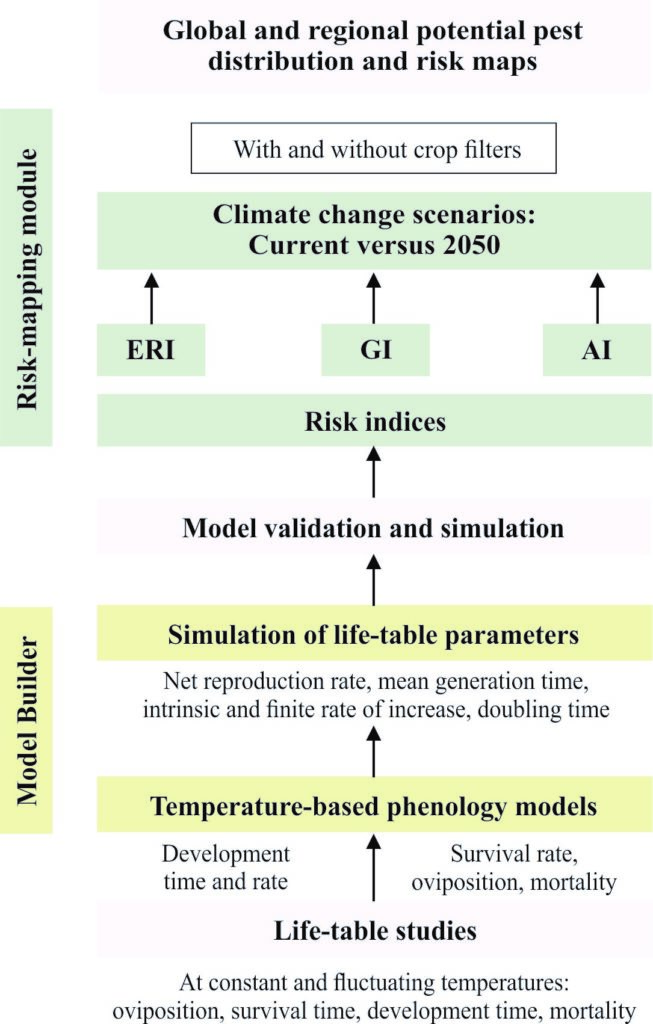THEORETICAL BACKGROUND AND REQUIREMENTS
Climate change will affect global and regional temperature increases differently (Govindasamy et al., 2003), and, hence, agro-ecosystems will be differently vulnerable to pests under future climates. Furthermore, temperature increases in already warmer tropical regions will increase insect abundance and activity proportionally more than in colder regions due to the already higher metabolism rates of organisms in these areas (Dillon et al., 2010). Therefore, a science-based framework to assess and better understand climate change-induced pest risks on global, regional, and local scales is needed to better inform the preparedness of stakeholders for adapting pest management strategies in a timely manner. A framework for assessing climate change impacts on future pest risks must consider:
- The potential establishment of an insect pest in a new environment;
- Its potential spread after an introduction; and
- Its potential economic impact in terms of pest abundance.
The Insect Life Cycle Modeling (ILCYM) software (developed by the International Potato Center or CIP) allows pest risk assessments to be conducted according to these criteria (Kroschel et al., 2013; Sporleder et al., 2013). It not only contributes to the pest risk analysis (PRA) framework as advocated by the International Plant Protection Convention (IPPC) (FAO, 2007), but also fills an important gap by providing detailed mapping information of pest risks in support of the International Standards for Phytosanitary Measures of the IPPC (IPCC, 2014).
THE ILCYM SOFTWARE FOR ASSESSING CLIMATE IMPACTS ON INSECT PESTS AND ASSOCIATED NATURAL ENEMIES
ILCYM is an open-source computer-aided tool built on R and Java codes and linked to the uDig platform, which is a Geographic Information System (GIS) that contains basic tools for mapping and managing geographic information (Sporleder et al. 2013; Tonnang et al. 2013). The software package has been used to develop global, regional, and country pest risk maps as part of this risk atlas (see Fig. 1). ILCYM consists of three modules:
- The model builder facilitates the development of insect phenology models based on life-table data derived from constant-temperature studies.
- The validation and simulation module provides tools for validating the developed phenology model using insect life-tables established for fluctuating temperature conditions.
- The potential population distribution and risk mapping module implements the phenology models in a GIS environment that allows for spatial—global or regional—simulations of species activities and risk mapping.
The relationship between aspects of insects’ life histories (i.e., development, survival, and reproduction) and environmental variables (e.g., temperature) can be well described by process-based phenology models. The model builder supports the establishment of process-based, temperature-driven and stage-specific phenology models. The analysis is based on empirical data (life-table or cohort studies) on the species generally collected in temperature-controlled experiments (see Annex 7.1). ILCYM’s model builder contains a library of empirical linear and nonlinear models to define critical temperature requirements of insects’ life histories.
Several statistical measures are provided for estimating parameters, comparing parameters, and selecting the best models. When all the sub-models required to describe the insect’s life history are completed, the software automatically compiles an overall age-stage structured phenology model which is used (after the model is successfully validated) to simulate the pest’s performance in a given temperature regime. Outputs are life-table parameters that include 1)net reproduction rate, 2) gross reproduction rate, 3) mean generation time, 4) intrinsic rate of increase, 5) finite rate of increase, and 6) the doubling time for a given temperature regime. Through these process-based analyses, the biology and temperature requirements of insects in general (e.g., pests, natural enemies, etc.) can be defined and the regions in which insects develop identified through GIS-simulation.
The validation and simulation modules are used to evaluate the ability of the developed phenology model to reproduce the insect species’ behavior under fluctuating, natural temperature conditions. This evaluation is achieved by comparing experimental life-table data obtained from fluctuating temperature studies (collected as described in Annex 7.1) with model outputs produced by using the same temperature records as input data. ILCYM stochastically simulates a user-defined number of life tables, each with a user-defined number of individuals, through rate summation and random determination for each individual’s survival, development to the next stage, and sex.
In the potential population distribution and risk mapping module, using the estimated life-table parameters, ILCYM calculates and maps three risk indices for assessing the potential establishment and population distribution, abundance, and spread of insect species (Box 1).

